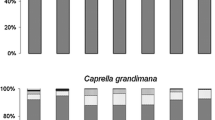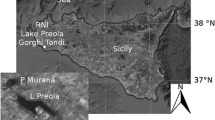Abstract
Gaetice depressus is one of the most dominant macrozoobenthos species in boulder shores of intertidal coastal ecosystems in Japan. As recorded in previous studies, this species is also considered as having high density and biomass. Consequently, it is thought to be one of the more important species in the organic matter flow of boulder shores, especially through the food web. In this study, some taxonomic problems related to G. depressus were tackled and the autoecology and ecological processes in the intertidal ecosystem of G. depressus, such as organic matter flow, were investigated. Furthermore, in order to clarify the taxonomy description, resolve inconsistencies in the scientific name, and learn about the life history, a literature review was conducted. Seasonal changes in density, morphology pattern and population structure were determined based on the data obtained in Ebisu Island, Japan. Then, the role of G. depressus was determined by estimating the intake and emittance fluxes of organic carbon and nitrogen through ingestion and egestion process in the boulder shores of Ebisu Island. A feeding rate experiment was also conducted in order to estimate the intake flux by using the catch-release-recapture method. Meanwhile, to estimate the emittance flux, a defecation rate experiment was conducted by catching some individuals of G. depressus, and then incubating them in the laboratory. The feeding rate measured by the speed of diet consumption of G. depressus was about 12.6 mg ind-1 h-1. Considering the average density, the intake flux through the feeding process could be estimated as 25.2 mgC m-2 h-1 and 2.6 mgN m-2 h-1. On the other hand, G. depressus egested fecal pellet at the rate of 5.4 mg ind-1 h-1. The average emittance flux through the fecal pellet egesting process is estimated at 5.6 mgC m-2 h-1 and 0.7 mgN m-2 h-1. Therefore, it can be estimated that about 25% of organic matter from diet is egested as fecal pellet, which means that about 75% of the intake flux of organic carbon and nitrogen is used for the total assimilation of G. depressus. Intake flux was also considered as affecting the high dynamism of primary producer consumption. The total population of G. depressus is estimated to consume about 18.4% of primary producer in average throughout the year. Therefore, the turnover time of primary producer by consumption of G. depressus was about five days.
Similar content being viewed by others
References
Davie PJF, Ng NK (2007) Two new subfamilies of Varunidae (Crustacea: Brachyura), with description of two new genera. Raffles B Zool Sup 16:257–272
De Haan W (1833–1850) Crustacea. In: De Siebold PF (ed) Fauna Japonica sive Descriptio Animalum, quae in Itinere per Japoniam, Jussu et Aufpiciis Superiorum, qui Summum in India Batava Imperium Tenent, Suscepto, Annis 1823–1830 Collegit, Notis, Observationibus et Adumbrationibus Illuftravit, Lugduni-Batavorum
Depledge MH (1989) Observations on the feeding behaviour of Gaetice depressus (Grapsidae: Varuninae) with special reference to suspension feeding. Mar Biol 100:253–259
Frangoulis C, Carlotti F, Eisenhauer L, Zervoudaki S (2010) Converting copepod vital rates into units appropriate for biogeochemical models. Prog Oceanogr 84:43–51
Fukui Y (1988) Comparative studies on the life history of the Grapsid crabs (Crustacea, Brachyura) inhabiting intertidal cobble and boulder shores. Pub Seto Mar Biol Lab 33:121–162
Fukui Y (1990) Breeding and moulting of Gaetice depressus (De Haan) (Brachyura: Grapsidae) under laboratory conditions. Res Crust 19:83–90
Fukui Y (1993) Timing of copulation in the molting and reproductive cycles in a Grapsid crab, Gaetice depressus (Crustacea: Brachyura). Mar Biol 117:221–226
Fukui Y (1995) The effects of body size on mate choice in a Grapsid crab, Gaetice depressus (Crustacea, Decapoda). J Ethol 13:1–8
Gili JM, Coma R (1998) Benthic suspension feeders: their paramount role in littoral marine food webs. Ecol Evol 13:316–321
Holthuis LB (1953) On the Dates of Publication of W. de Haan’s Volume on the Crustacea of P. F. von Siebold’s “Fauna Japonica”. Arch Nat Hist 3:36–47
Itoh H, Aoki MN, Tsuchiya Y, Sato T, Shinagawa H, Komatsu T, Mikami A, Hama T (2007) Fate of organic matter in faecal pellets egested by epifaunal mesograzers in a Sargassum forest and implications for biogeochemical cycling. Mar Ecol-Prog Ser 352:101–112
Jeng MS (1997) Studies on the land and aquatic decapod crustacean fauna of the Kenting National Park (2): communities of decapod crustaceans around the sea. Ministry of the Interior, Pingtung, Taipei, 66 p
Kim HS, Chang C (1985) The brachyuran crabs of Cheju Island, Korea (Crustacea: Decapoda). Korean J Syst Zool 1:41–60
Komai T, Maruyama S, Konishi K (1992) A list of Decapod Crustaceans from Hokkaido, Northern Japan. Res Crustacea 21:189–205
Lee SY (1997) Potential trophic importance of the faecal material of the mangrove sesarmine crab Sesarma messa. Mar Ecol-Prog Ser 159:275–284
Lohrer AM, Fukui Y, Wada K, Whitlatch RB (2000) Structural complexity and vertical zonation of intertidal crabs, with focus on habitat requirements of the invasive Asian shore crab, Hemigrapsus sanguineus (De Haan). J Exp Mar Biol Ecol 244:203–217
Miyake S (1983) Japanese Crustacean Decapods and Stomatopods in Color Vol. II-Brachyura (Crabs). Hoikusha Publishing Co. Ltd., Osaka, Japan
MSIP (2012) Marine Species Identification Portal-Gaetice depressus. http://species-identification.org/species.php?species_group =crabs_of_japan&menuentry=soorten&id=1702&tab=beschrijving Accessed 23 Feb 2012
Ng PKL, Guinot D, Davie PJF (2008) Systema brachyurorum I: an annotated checklist of extant bracyuran crabs of the world. Raffles B Zool Sup 17:1–286
Nienhuis PH (1981) Distribution of organic matter in living marine organisms. In: Duursana EK, Dawson R (eds) Marine organic chemistry: evolution, composition, interaction and chemistry of organic matter in seawater. Elsevier, Amsterdam, pp 31–69
Nordhaus I, Wolff M (2007) Feeding ecology of the mangrove crab Ucides cordatus (Ocypodidae): food choice, food quality and assimilation efficiency. Mar Biol 151:1665–1681
Parsons TR, Takahashi M, Hargrave B (1988) Biological Oceanographic Processes. Pergamon Press, Oxford, 322 p
R Development Core Team (2011) R: A language and environment for statistical computing. R Foundation for Statistical Computing, Vienna, Austria, 3551 p
Ride WDL, Cogger HG, Dupuis C, Kraus O, Minelli A, Thompson FC, Tubbs PK (1999) International code of zoological nomenclature. The International Trust for Zoological Nomenclature, International Commission of Zoological Nomenclature.
Robertson AI, Lucas JS (1983) Food choice, feeding rates and the turnover of macrophyte biomass by a surf-zone inhabiting amphipod. J Exp Mar Biol Ecol 72:99–124
Sakai T (1935) List of marine animals around Shimoda area: biological report of Shimoda Marine Biological Station. Tokyo University of Literature and Science, 1:23–85, 3 pls, 2 maps (In Japanese)
Sakamoto R, Ito A, Wada S (2006) Combined effect of risk type and activity rhythm on anti-predator response of the shore crab Gaetice depressus (Crustacea: Grapsidae). J Mar Biol Assoc UK 86:1401–1405
Schultes S (2004) The role of mesozooplankton grazing in the biogeochemical cycle of silicon in the Southern Ocean. Ph.D. Thesis, University of Bremen
Stimpson W (1907) Report on the Crustacea (Brachyura and Anomura) collected by the North Pacific Exploring Expedition, 1853–1856. Smithsonian Institution, Washington, 310 p
Sugamoto Y (2012) Measurement of primary productivity at Boulder Shore and its contribution to the coastal ecosystem. M.S. Thesis, University of Tsukuba, Japan, 49 p
Takada Y (1999) Influence of shade and number of boulder layers on mobile organisms on a warm temperate boulder shore. Mar Ecol-Prog Ser 189:171–179
Turner JT (2002) Zooplankton fecal pellets, marine snow and sinking phytoplankton blooms. Aquat Microb Ecol 27:57–102
Author information
Authors and Affiliations
Corresponding author
Rights and permissions
About this article
Cite this article
Wahyudi, A.J., Wada, S., Aoki, M. et al. Gaetice depressus (Crustacea, Varunidae): Species profile and its role in organic carbon and nitrogen flow. Ocean Sci. J. 50, 389–401 (2015). https://doi.org/10.1007/s12601-015-0036-y
Received:
Revised:
Accepted:
Published:
Issue Date:
DOI: https://doi.org/10.1007/s12601-015-0036-y




